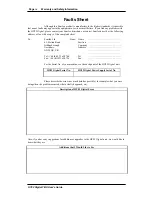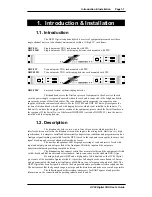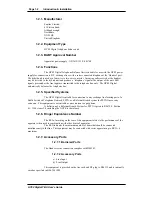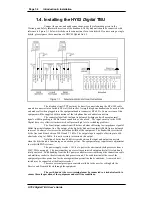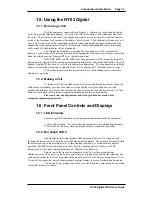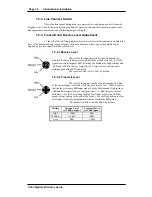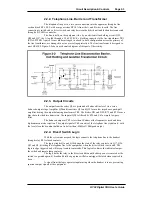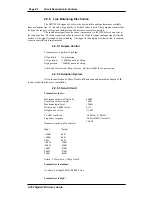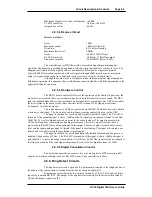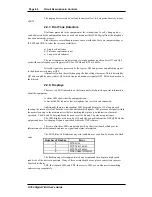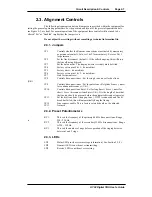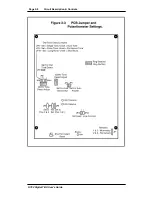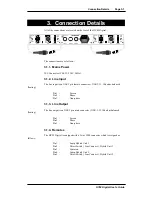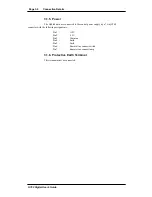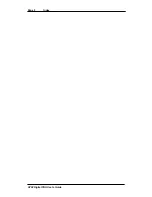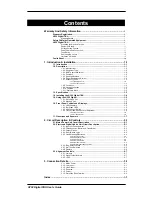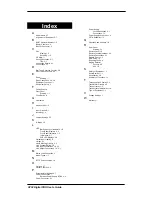
Circuit Description & Controls Page 2-5
HY02 Digital TBU User's Guide
Maximum output level to line (soft limited) : +6dBM
Tx LED sensitivity :
-7dB on, -10dB off
Output noise to line :
-66dB
2.2.5.4 Receive Circuit
Receive set to low:
Gain
:
+9dB
Maximum output :
+8dB (soft limited)
Distortion
:
0.1%
before
limiting
Maximum input level :
20dBm
Noise
:
-66dB
(-77dB
off
line)
Rx LED sensitivity :
-14dB on, -17dB off at output
Frequency response :
-3dB 250HZ, flat to 3.5 kHz.
The cancellation uses FIR filters with a normalised signal dependent adaption
algorithm. The adaption is disabled during double-talk and when the signals are too low in level. The
adaption coefficients are held digitally and are not subject to drift when no signals are present.
Typically 40dB of rejection is achieved with real signals although 60dB rejection can be measured
using test signals into dummy lines. Send and receive levels are set up by on-board links.
Although the board works in full duplex mode, links can program signal dependent
half duplex operation; this enhances the overall sidetone rejection/stability with little degradation to the
apparent full duplex operation.
2.2.5.5 Hardware Control
The DSP is used to control all facets of the operation of the board. On power up, the
digital devices are checked for correct operation and a status led flashes if errors are found. The DSP
reads the onboard links and sets the operational mode signal levels accordingly. The DSP also controls
the divert status of the board via the codec auxiliary data I/O channel. The signals are software
‘debounced’ for stable operation.
The send and receive LEDS are processed via the DSP. These have hysterisis built in
to minimise ‘chattering’. The divert relay and two/four wire mode control is driven via the DSP.
The signal is checked for overload, and digitally limited if needed. The ‘Tx LED’ is
turned on if the outgoing signal is above -14dB and the Tx signal is gain reduced if found to be below -
24dB. The Tx level is adjusted before being sent to the codec send port. The signal is processed in
16/32 bits throughout, to maintain good audio performance. The receive signal from the codec is
processed via the DSP before being presented to the output. The receive signal is checked for excess
level and the input analogue signal is limited if the signal is overloading. The signal is then high-pass
filtered and, if enabled, network cancellation is implemented.
The signal is checked for overload and digitally limited if needed and the receive is
disabled if the board is ‘off line’. The ‘Rx LED’ is turned on if the signal is above -14dB and signal is
gain reduced ( i.e. noise reduction is introduced ) if it is below -24dB. The signal is also gain reduced if
levelling is desired, and the send signal is dominant. Receive level is adjustable from 9 to 21dB.
2.2.5.6 Digital Cancellation Control
Fixed sidetone cancellation occurs in two wire mode prior to DSP processing. Full
adaptive network cancellation is achieved by DSP means. Echo cancellation is 28ms.
2.2.6. Ring Detect Circuits
The ring detector circuit is optional. It is permanently coupled to the telephone line at
the handset relay contacts and is isolated from the line by the optocoupler Q13.
Ringing tones are detected by the circuitry formed by Q12, Q11, Q10 and Q9. Ring
sensitivity is adjusted by RV3. The output of the ring detector is coupled to the divert switch latch by
Q7 and the jumper connection JP3.
Summary of Contents for HY02 DIGITAL
Page 14: ...Page 1 8 Introduction Installation HY02 Digital TBU User s Guide This page deliberately blank ...
Page 16: ...Page 2 2 Circuit Description Controls HY02 Digital TBU User s Guide ...
Page 22: ...Page 2 8 Circuit Description Controls HY02 Digital TBU User s Guide ...
Page 25: ...Page 0 Index HY02 Digital TBU User s Guide ...
Page 27: ...HY02 Digital TBU User s Guide ...

